Visual Culture: Narratives of Collective Identity and Prevalent Myths
VerifiedAdded on 2020/02/24
|7
|1998
|110
Essay
AI Summary
This essay delves into the impact of homogenizing narratives of collective identity and prevalent myths on visual culture, with a focus on art and film. It examines how these narratives shape the presentation and perception of culture in modern society, using the film "Smiling Indians" as a key example. The analysis explores the influence of the Curtis photographs and their impact on the portrayal of indigenous people, contrasting them with contemporary representations. The essay highlights how visual culture, empowered by technology and the internet, allows indigenous communities to create their own visions and challenge historical stereotypes. It discusses the power of native-produced films and performances to deconstruct and reimagine cultural images, advocating for a deeper understanding of cultural objects and the complexities of identity in visual media. The essay also touches on the role of media and film projects in shaping the self-image of the native people.
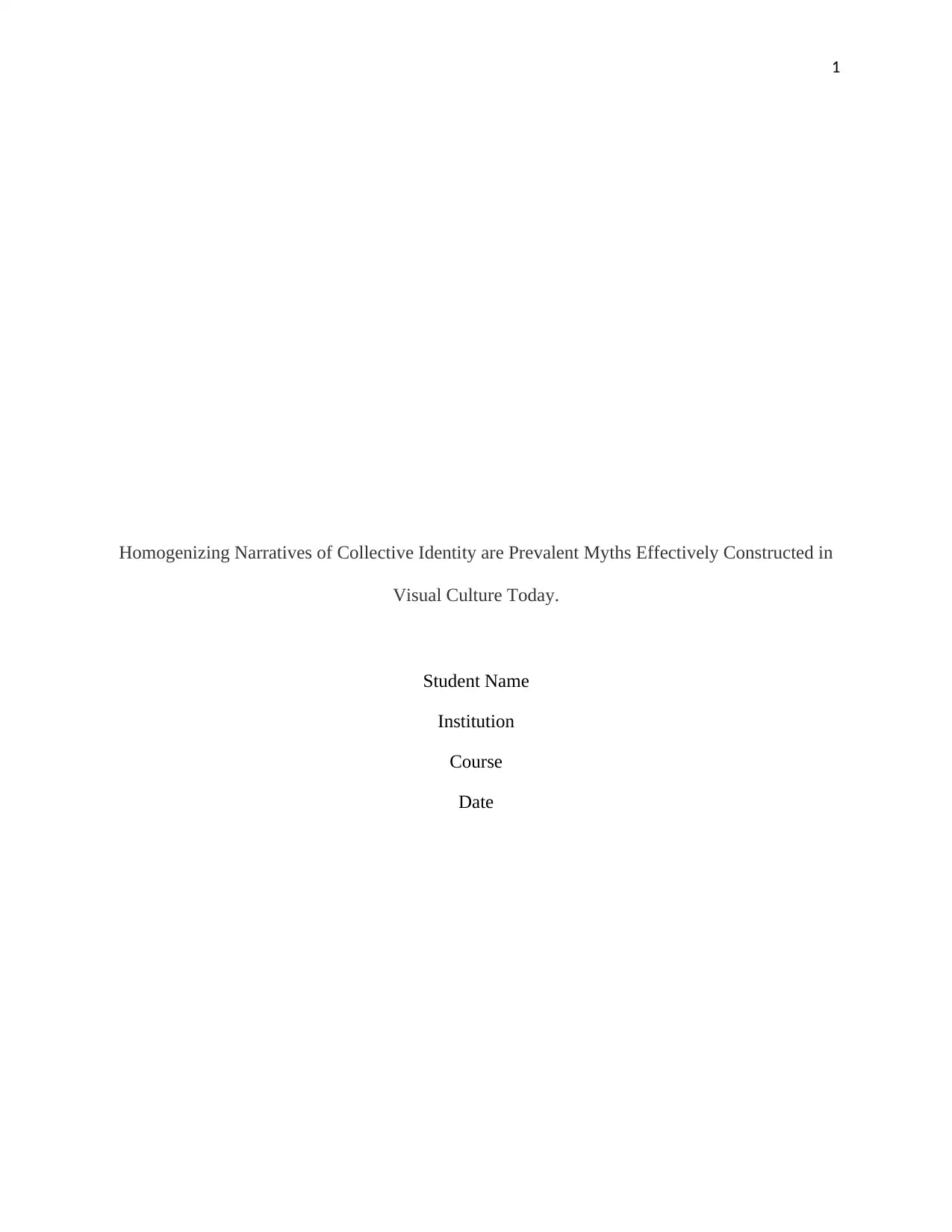
1
Homogenizing Narratives of Collective Identity are Prevalent Myths Effectively Constructed in
Visual Culture Today.
Student Name
Institution
Course
Date
Homogenizing Narratives of Collective Identity are Prevalent Myths Effectively Constructed in
Visual Culture Today.
Student Name
Institution
Course
Date
Paraphrase This Document
Need a fresh take? Get an instant paraphrase of this document with our AI Paraphraser
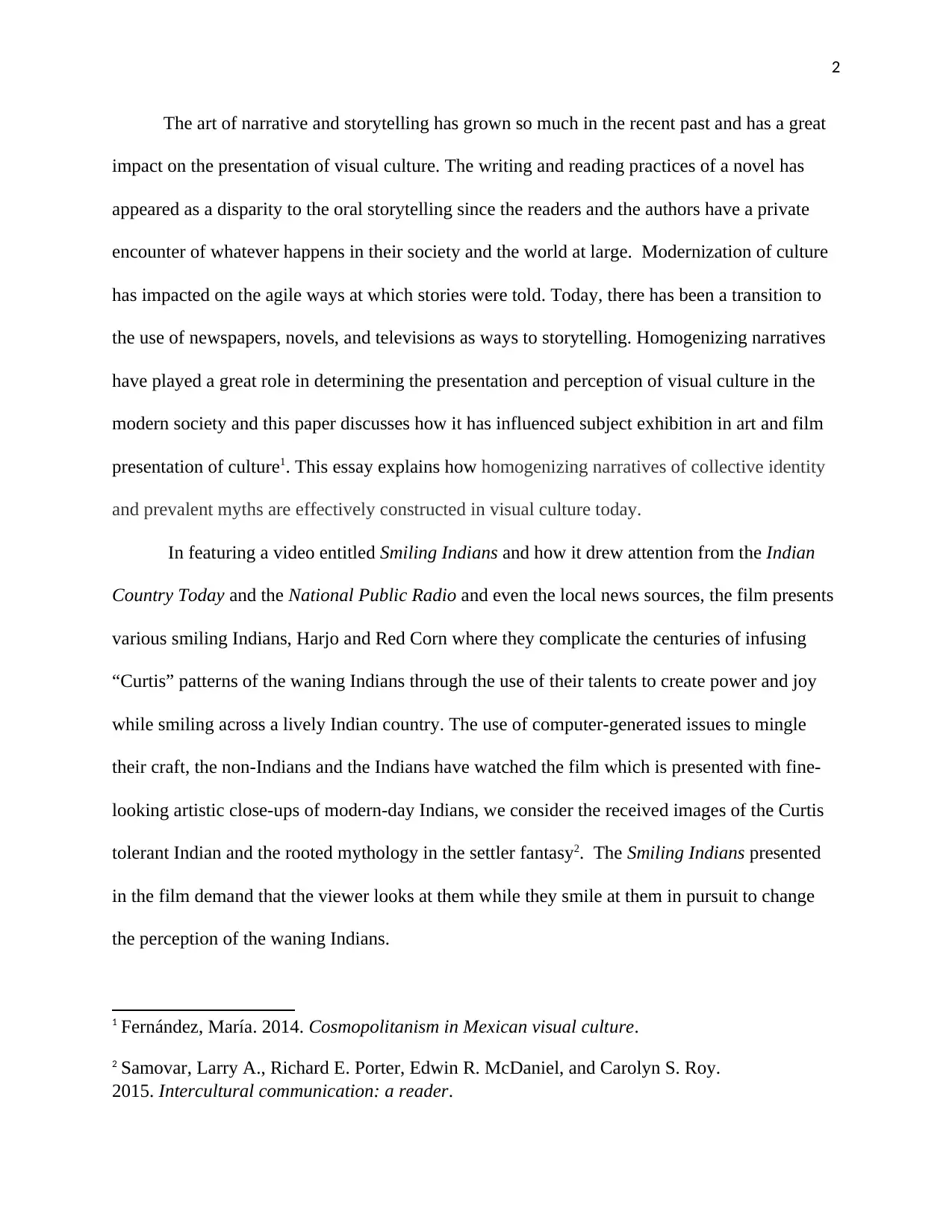
2
The art of narrative and storytelling has grown so much in the recent past and has a great
impact on the presentation of visual culture. The writing and reading practices of a novel has
appeared as a disparity to the oral storytelling since the readers and the authors have a private
encounter of whatever happens in their society and the world at large. Modernization of culture
has impacted on the agile ways at which stories were told. Today, there has been a transition to
the use of newspapers, novels, and televisions as ways to storytelling. Homogenizing narratives
have played a great role in determining the presentation and perception of visual culture in the
modern society and this paper discusses how it has influenced subject exhibition in art and film
presentation of culture1. This essay explains how homogenizing narratives of collective identity
and prevalent myths are effectively constructed in visual culture today.
In featuring a video entitled Smiling Indians and how it drew attention from the Indian
Country Today and the National Public Radio and even the local news sources, the film presents
various smiling Indians, Harjo and Red Corn where they complicate the centuries of infusing
“Curtis” patterns of the waning Indians through the use of their talents to create power and joy
while smiling across a lively Indian country. The use of computer-generated issues to mingle
their craft, the non-Indians and the Indians have watched the film which is presented with fine-
looking artistic close-ups of modern-day Indians, we consider the received images of the Curtis
tolerant Indian and the rooted mythology in the settler fantasy2. The Smiling Indians presented
in the film demand that the viewer looks at them while they smile at them in pursuit to change
the perception of the waning Indians.
1 Fernández, María. 2014. Cosmopolitanism in Mexican visual culture.
2 Samovar, Larry A., Richard E. Porter, Edwin R. McDaniel, and Carolyn S. Roy.
2015. Intercultural communication: a reader.
The art of narrative and storytelling has grown so much in the recent past and has a great
impact on the presentation of visual culture. The writing and reading practices of a novel has
appeared as a disparity to the oral storytelling since the readers and the authors have a private
encounter of whatever happens in their society and the world at large. Modernization of culture
has impacted on the agile ways at which stories were told. Today, there has been a transition to
the use of newspapers, novels, and televisions as ways to storytelling. Homogenizing narratives
have played a great role in determining the presentation and perception of visual culture in the
modern society and this paper discusses how it has influenced subject exhibition in art and film
presentation of culture1. This essay explains how homogenizing narratives of collective identity
and prevalent myths are effectively constructed in visual culture today.
In featuring a video entitled Smiling Indians and how it drew attention from the Indian
Country Today and the National Public Radio and even the local news sources, the film presents
various smiling Indians, Harjo and Red Corn where they complicate the centuries of infusing
“Curtis” patterns of the waning Indians through the use of their talents to create power and joy
while smiling across a lively Indian country. The use of computer-generated issues to mingle
their craft, the non-Indians and the Indians have watched the film which is presented with fine-
looking artistic close-ups of modern-day Indians, we consider the received images of the Curtis
tolerant Indian and the rooted mythology in the settler fantasy2. The Smiling Indians presented
in the film demand that the viewer looks at them while they smile at them in pursuit to change
the perception of the waning Indians.
1 Fernández, María. 2014. Cosmopolitanism in Mexican visual culture.
2 Samovar, Larry A., Richard E. Porter, Edwin R. McDaniel, and Carolyn S. Roy.
2015. Intercultural communication: a reader.
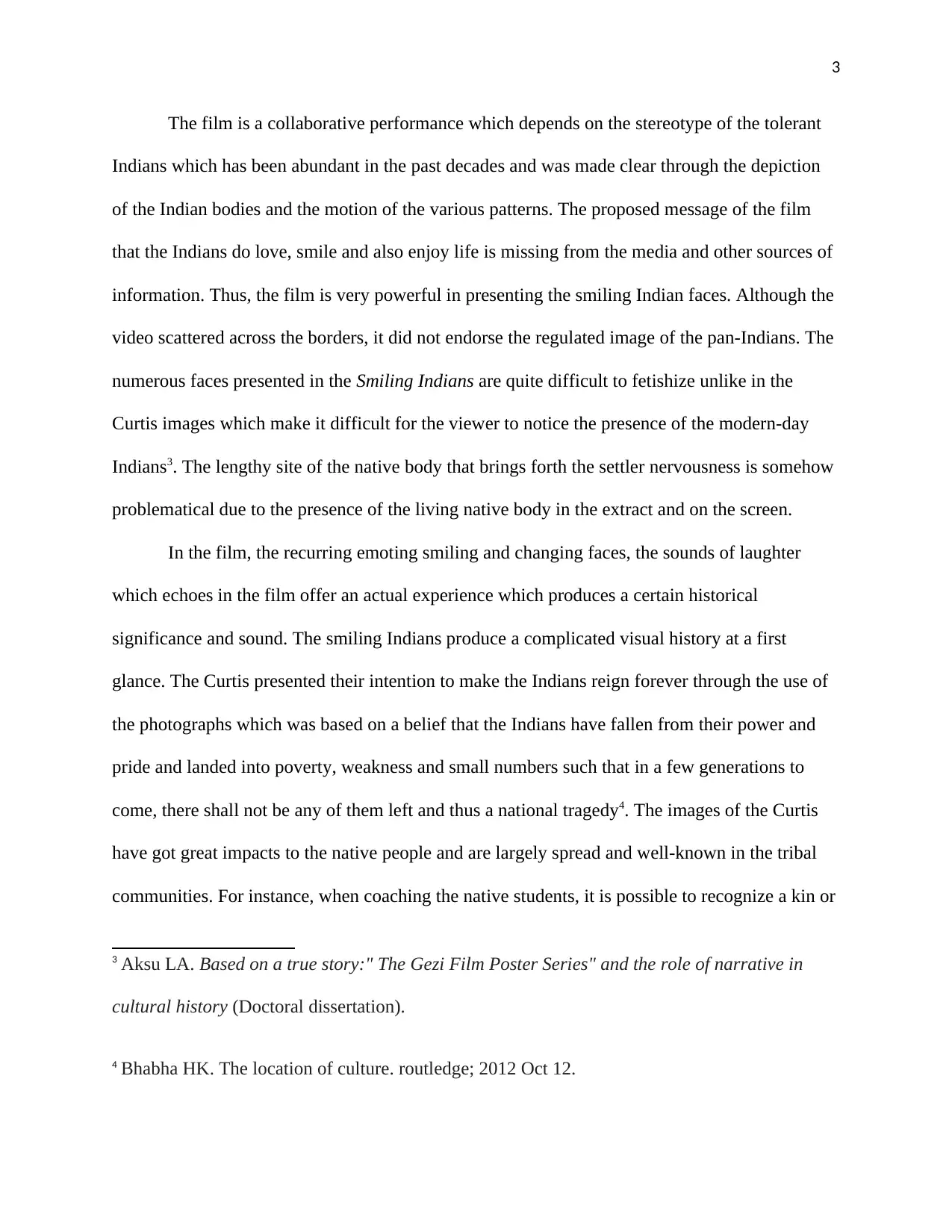
3
The film is a collaborative performance which depends on the stereotype of the tolerant
Indians which has been abundant in the past decades and was made clear through the depiction
of the Indian bodies and the motion of the various patterns. The proposed message of the film
that the Indians do love, smile and also enjoy life is missing from the media and other sources of
information. Thus, the film is very powerful in presenting the smiling Indian faces. Although the
video scattered across the borders, it did not endorse the regulated image of the pan-Indians. The
numerous faces presented in the Smiling Indians are quite difficult to fetishize unlike in the
Curtis images which make it difficult for the viewer to notice the presence of the modern-day
Indians3. The lengthy site of the native body that brings forth the settler nervousness is somehow
problematical due to the presence of the living native body in the extract and on the screen.
In the film, the recurring emoting smiling and changing faces, the sounds of laughter
which echoes in the film offer an actual experience which produces a certain historical
significance and sound. The smiling Indians produce a complicated visual history at a first
glance. The Curtis presented their intention to make the Indians reign forever through the use of
the photographs which was based on a belief that the Indians have fallen from their power and
pride and landed into poverty, weakness and small numbers such that in a few generations to
come, there shall not be any of them left and thus a national tragedy4. The images of the Curtis
have got great impacts to the native people and are largely spread and well-known in the tribal
communities. For instance, when coaching the native students, it is possible to recognize a kin or
3 Aksu LA. Based on a true story:" The Gezi Film Poster Series" and the role of narrative in
cultural history (Doctoral dissertation).
4 Bhabha HK. The location of culture. routledge; 2012 Oct 12.
The film is a collaborative performance which depends on the stereotype of the tolerant
Indians which has been abundant in the past decades and was made clear through the depiction
of the Indian bodies and the motion of the various patterns. The proposed message of the film
that the Indians do love, smile and also enjoy life is missing from the media and other sources of
information. Thus, the film is very powerful in presenting the smiling Indian faces. Although the
video scattered across the borders, it did not endorse the regulated image of the pan-Indians. The
numerous faces presented in the Smiling Indians are quite difficult to fetishize unlike in the
Curtis images which make it difficult for the viewer to notice the presence of the modern-day
Indians3. The lengthy site of the native body that brings forth the settler nervousness is somehow
problematical due to the presence of the living native body in the extract and on the screen.
In the film, the recurring emoting smiling and changing faces, the sounds of laughter
which echoes in the film offer an actual experience which produces a certain historical
significance and sound. The smiling Indians produce a complicated visual history at a first
glance. The Curtis presented their intention to make the Indians reign forever through the use of
the photographs which was based on a belief that the Indians have fallen from their power and
pride and landed into poverty, weakness and small numbers such that in a few generations to
come, there shall not be any of them left and thus a national tragedy4. The images of the Curtis
have got great impacts to the native people and are largely spread and well-known in the tribal
communities. For instance, when coaching the native students, it is possible to recognize a kin or
3 Aksu LA. Based on a true story:" The Gezi Film Poster Series" and the role of narrative in
cultural history (Doctoral dissertation).
4 Bhabha HK. The location of culture. routledge; 2012 Oct 12.
⊘ This is a preview!⊘
Do you want full access?
Subscribe today to unlock all pages.

Trusted by 1+ million students worldwide
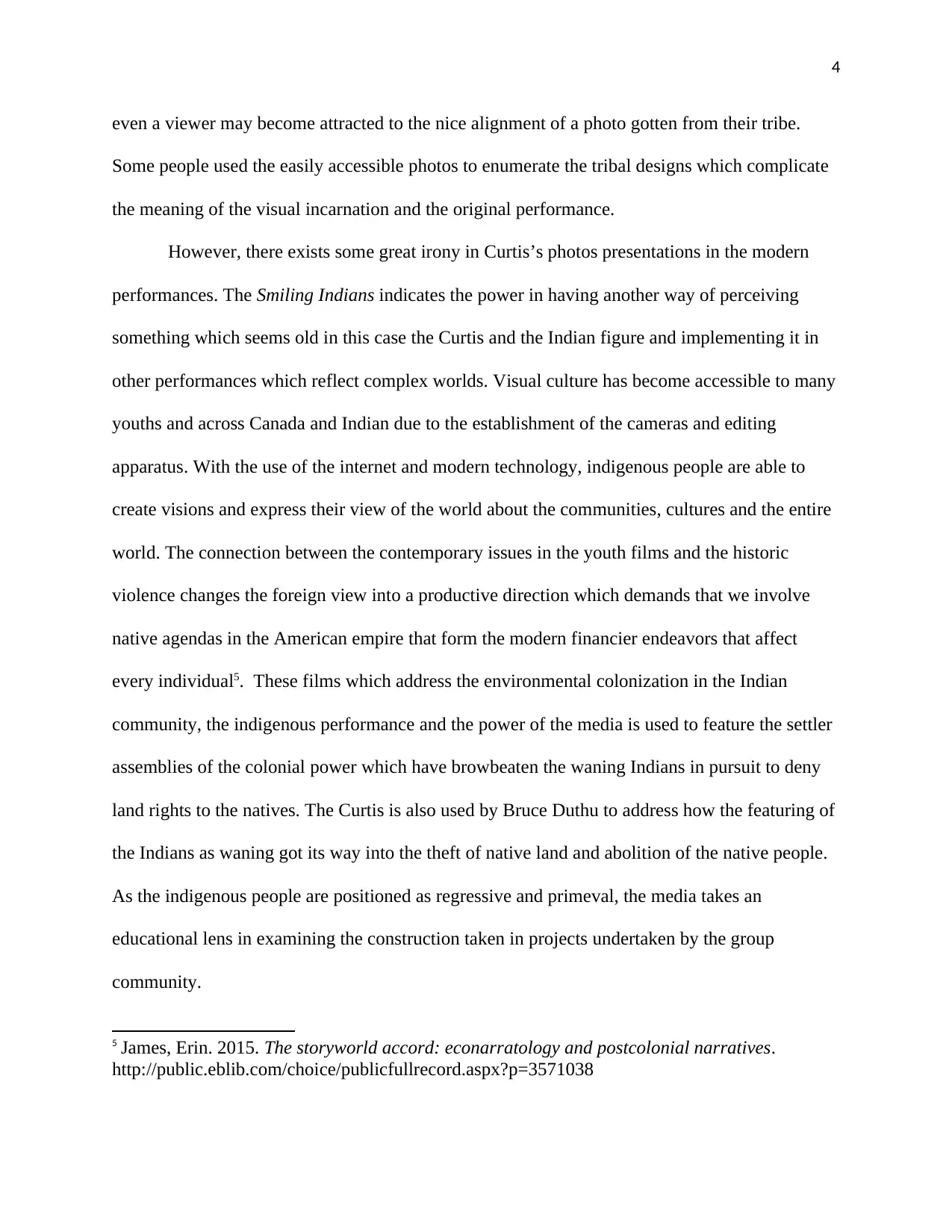
4
even a viewer may become attracted to the nice alignment of a photo gotten from their tribe.
Some people used the easily accessible photos to enumerate the tribal designs which complicate
the meaning of the visual incarnation and the original performance.
However, there exists some great irony in Curtis’s photos presentations in the modern
performances. The Smiling Indians indicates the power in having another way of perceiving
something which seems old in this case the Curtis and the Indian figure and implementing it in
other performances which reflect complex worlds. Visual culture has become accessible to many
youths and across Canada and Indian due to the establishment of the cameras and editing
apparatus. With the use of the internet and modern technology, indigenous people are able to
create visions and express their view of the world about the communities, cultures and the entire
world. The connection between the contemporary issues in the youth films and the historic
violence changes the foreign view into a productive direction which demands that we involve
native agendas in the American empire that form the modern financier endeavors that affect
every individual5. These films which address the environmental colonization in the Indian
community, the indigenous performance and the power of the media is used to feature the settler
assemblies of the colonial power which have browbeaten the waning Indians in pursuit to deny
land rights to the natives. The Curtis is also used by Bruce Duthu to address how the featuring of
the Indians as waning got its way into the theft of native land and abolition of the native people.
As the indigenous people are positioned as regressive and primeval, the media takes an
educational lens in examining the construction taken in projects undertaken by the group
community.
5 James, Erin. 2015. The storyworld accord: econarratology and postcolonial narratives.
http://public.eblib.com/choice/publicfullrecord.aspx?p=3571038
even a viewer may become attracted to the nice alignment of a photo gotten from their tribe.
Some people used the easily accessible photos to enumerate the tribal designs which complicate
the meaning of the visual incarnation and the original performance.
However, there exists some great irony in Curtis’s photos presentations in the modern
performances. The Smiling Indians indicates the power in having another way of perceiving
something which seems old in this case the Curtis and the Indian figure and implementing it in
other performances which reflect complex worlds. Visual culture has become accessible to many
youths and across Canada and Indian due to the establishment of the cameras and editing
apparatus. With the use of the internet and modern technology, indigenous people are able to
create visions and express their view of the world about the communities, cultures and the entire
world. The connection between the contemporary issues in the youth films and the historic
violence changes the foreign view into a productive direction which demands that we involve
native agendas in the American empire that form the modern financier endeavors that affect
every individual5. These films which address the environmental colonization in the Indian
community, the indigenous performance and the power of the media is used to feature the settler
assemblies of the colonial power which have browbeaten the waning Indians in pursuit to deny
land rights to the natives. The Curtis is also used by Bruce Duthu to address how the featuring of
the Indians as waning got its way into the theft of native land and abolition of the native people.
As the indigenous people are positioned as regressive and primeval, the media takes an
educational lens in examining the construction taken in projects undertaken by the group
community.
5 James, Erin. 2015. The storyworld accord: econarratology and postcolonial narratives.
http://public.eblib.com/choice/publicfullrecord.aspx?p=3571038
Paraphrase This Document
Need a fresh take? Get an instant paraphrase of this document with our AI Paraphraser
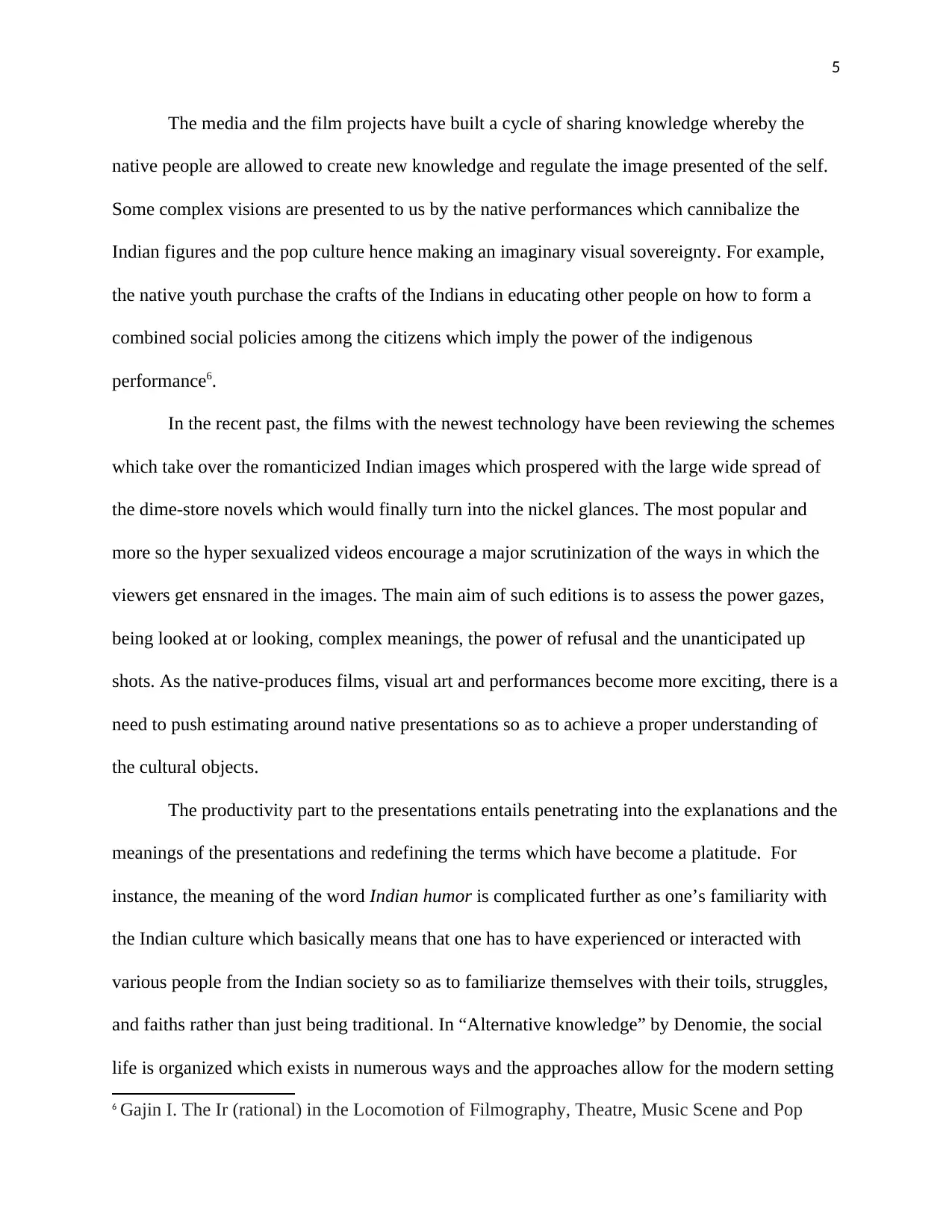
5
The media and the film projects have built a cycle of sharing knowledge whereby the
native people are allowed to create new knowledge and regulate the image presented of the self.
Some complex visions are presented to us by the native performances which cannibalize the
Indian figures and the pop culture hence making an imaginary visual sovereignty. For example,
the native youth purchase the crafts of the Indians in educating other people on how to form a
combined social policies among the citizens which imply the power of the indigenous
performance6.
In the recent past, the films with the newest technology have been reviewing the schemes
which take over the romanticized Indian images which prospered with the large wide spread of
the dime-store novels which would finally turn into the nickel glances. The most popular and
more so the hyper sexualized videos encourage a major scrutinization of the ways in which the
viewers get ensnared in the images. The main aim of such editions is to assess the power gazes,
being looked at or looking, complex meanings, the power of refusal and the unanticipated up
shots. As the native-produces films, visual art and performances become more exciting, there is a
need to push estimating around native presentations so as to achieve a proper understanding of
the cultural objects.
The productivity part to the presentations entails penetrating into the explanations and the
meanings of the presentations and redefining the terms which have become a platitude. For
instance, the meaning of the word Indian humor is complicated further as one’s familiarity with
the Indian culture which basically means that one has to have experienced or interacted with
various people from the Indian society so as to familiarize themselves with their toils, struggles,
and faiths rather than just being traditional. In “Alternative knowledge” by Denomie, the social
life is organized which exists in numerous ways and the approaches allow for the modern setting
6 Gajin I. The Ir (rational) in the Locomotion of Filmography, Theatre, Music Scene and Pop
The media and the film projects have built a cycle of sharing knowledge whereby the
native people are allowed to create new knowledge and regulate the image presented of the self.
Some complex visions are presented to us by the native performances which cannibalize the
Indian figures and the pop culture hence making an imaginary visual sovereignty. For example,
the native youth purchase the crafts of the Indians in educating other people on how to form a
combined social policies among the citizens which imply the power of the indigenous
performance6.
In the recent past, the films with the newest technology have been reviewing the schemes
which take over the romanticized Indian images which prospered with the large wide spread of
the dime-store novels which would finally turn into the nickel glances. The most popular and
more so the hyper sexualized videos encourage a major scrutinization of the ways in which the
viewers get ensnared in the images. The main aim of such editions is to assess the power gazes,
being looked at or looking, complex meanings, the power of refusal and the unanticipated up
shots. As the native-produces films, visual art and performances become more exciting, there is a
need to push estimating around native presentations so as to achieve a proper understanding of
the cultural objects.
The productivity part to the presentations entails penetrating into the explanations and the
meanings of the presentations and redefining the terms which have become a platitude. For
instance, the meaning of the word Indian humor is complicated further as one’s familiarity with
the Indian culture which basically means that one has to have experienced or interacted with
various people from the Indian society so as to familiarize themselves with their toils, struggles,
and faiths rather than just being traditional. In “Alternative knowledge” by Denomie, the social
life is organized which exists in numerous ways and the approaches allow for the modern setting
6 Gajin I. The Ir (rational) in the Locomotion of Filmography, Theatre, Music Scene and Pop
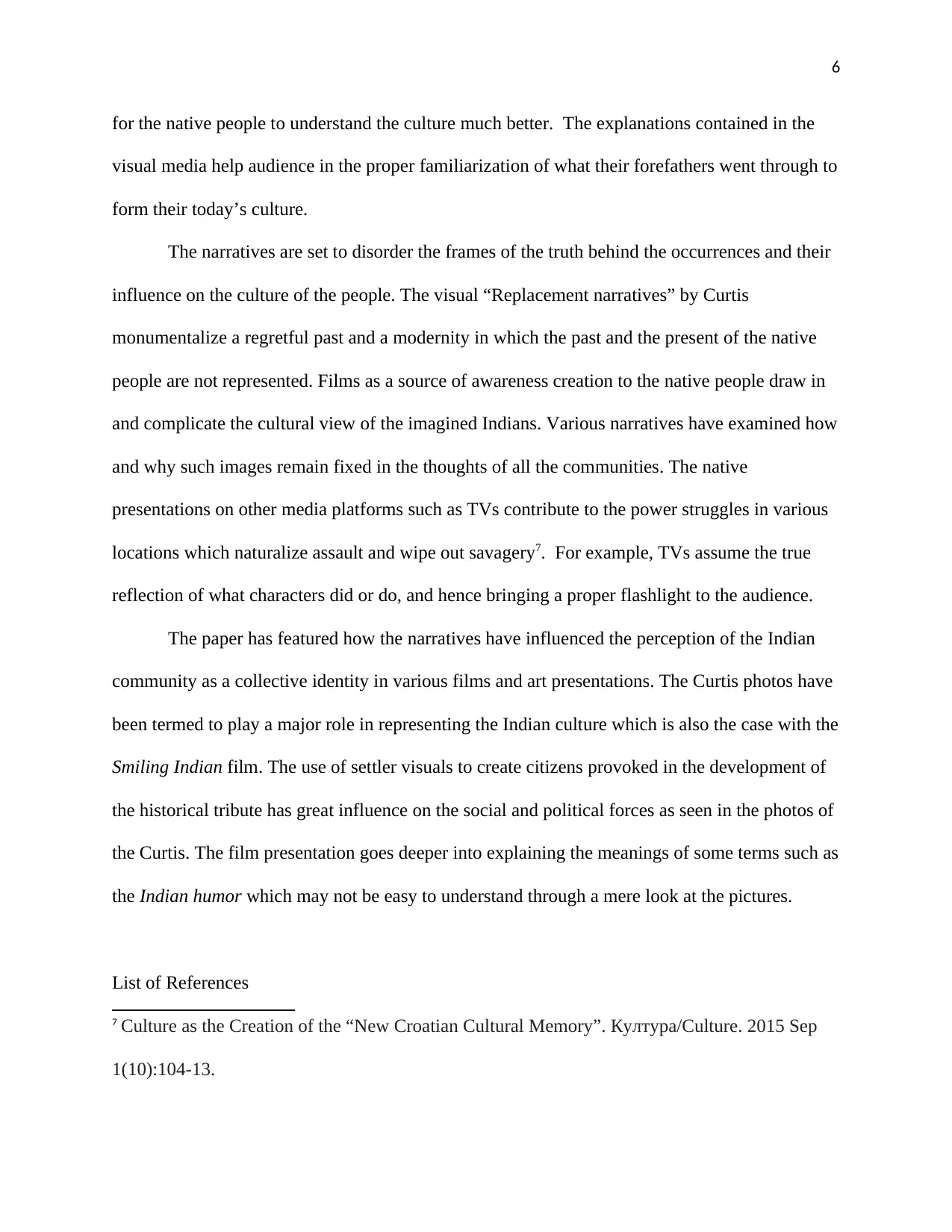
6
for the native people to understand the culture much better. The explanations contained in the
visual media help audience in the proper familiarization of what their forefathers went through to
form their today’s culture.
The narratives are set to disorder the frames of the truth behind the occurrences and their
influence on the culture of the people. The visual “Replacement narratives” by Curtis
monumentalize a regretful past and a modernity in which the past and the present of the native
people are not represented. Films as a source of awareness creation to the native people draw in
and complicate the cultural view of the imagined Indians. Various narratives have examined how
and why such images remain fixed in the thoughts of all the communities. The native
presentations on other media platforms such as TVs contribute to the power struggles in various
locations which naturalize assault and wipe out savagery7. For example, TVs assume the true
reflection of what characters did or do, and hence bringing a proper flashlight to the audience.
The paper has featured how the narratives have influenced the perception of the Indian
community as a collective identity in various films and art presentations. The Curtis photos have
been termed to play a major role in representing the Indian culture which is also the case with the
Smiling Indian film. The use of settler visuals to create citizens provoked in the development of
the historical tribute has great influence on the social and political forces as seen in the photos of
the Curtis. The film presentation goes deeper into explaining the meanings of some terms such as
the Indian humor which may not be easy to understand through a mere look at the pictures.
List of References
7 Culture as the Creation of the “New Croatian Cultural Memory”. Култура/Culture. 2015 Sep
1(10):104-13.
for the native people to understand the culture much better. The explanations contained in the
visual media help audience in the proper familiarization of what their forefathers went through to
form their today’s culture.
The narratives are set to disorder the frames of the truth behind the occurrences and their
influence on the culture of the people. The visual “Replacement narratives” by Curtis
monumentalize a regretful past and a modernity in which the past and the present of the native
people are not represented. Films as a source of awareness creation to the native people draw in
and complicate the cultural view of the imagined Indians. Various narratives have examined how
and why such images remain fixed in the thoughts of all the communities. The native
presentations on other media platforms such as TVs contribute to the power struggles in various
locations which naturalize assault and wipe out savagery7. For example, TVs assume the true
reflection of what characters did or do, and hence bringing a proper flashlight to the audience.
The paper has featured how the narratives have influenced the perception of the Indian
community as a collective identity in various films and art presentations. The Curtis photos have
been termed to play a major role in representing the Indian culture which is also the case with the
Smiling Indian film. The use of settler visuals to create citizens provoked in the development of
the historical tribute has great influence on the social and political forces as seen in the photos of
the Curtis. The film presentation goes deeper into explaining the meanings of some terms such as
the Indian humor which may not be easy to understand through a mere look at the pictures.
List of References
7 Culture as the Creation of the “New Croatian Cultural Memory”. Култура/Culture. 2015 Sep
1(10):104-13.
⊘ This is a preview!⊘
Do you want full access?
Subscribe today to unlock all pages.

Trusted by 1+ million students worldwide
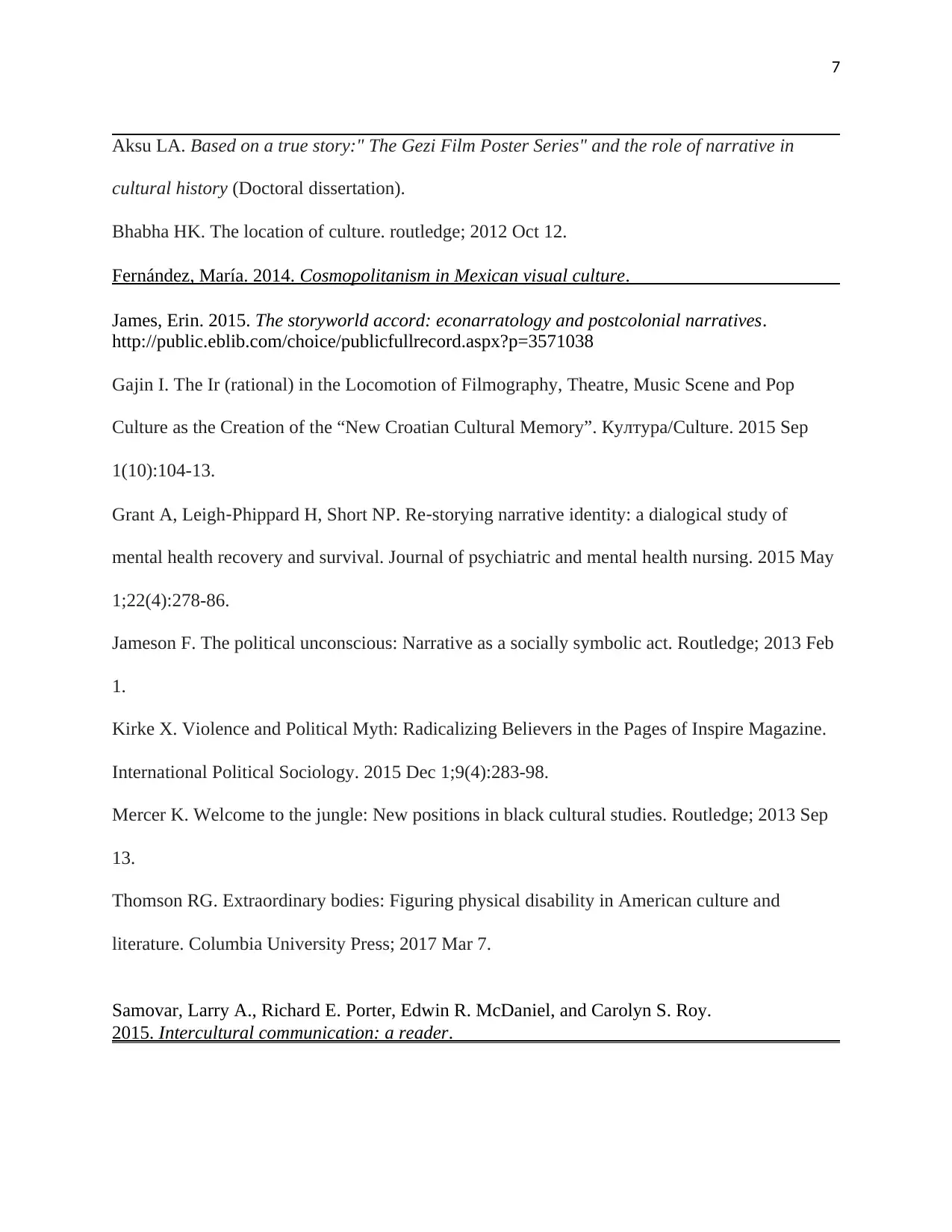
7
Aksu LA. Based on a true story:" The Gezi Film Poster Series" and the role of narrative in
cultural history (Doctoral dissertation).
Bhabha HK. The location of culture. routledge; 2012 Oct 12.
Fernández, María. 2014. Cosmopolitanism in Mexican visual culture.
James, Erin. 2015. The storyworld accord: econarratology and postcolonial narratives.
http://public.eblib.com/choice/publicfullrecord.aspx?p=3571038
Gajin I. The Ir (rational) in the Locomotion of Filmography, Theatre, Music Scene and Pop
Culture as the Creation of the “New Croatian Cultural Memory”. Култура/Culture. 2015 Sep
1(10):104-13.
Grant A, Leigh‐Phippard H, Short NP. Re‐storying narrative identity: a dialogical study of
mental health recovery and survival. Journal of psychiatric and mental health nursing. 2015 May
1;22(4):278-86.
Jameson F. The political unconscious: Narrative as a socially symbolic act. Routledge; 2013 Feb
1.
Kirke X. Violence and Political Myth: Radicalizing Believers in the Pages of Inspire Magazine.
International Political Sociology. 2015 Dec 1;9(4):283-98.
Mercer K. Welcome to the jungle: New positions in black cultural studies. Routledge; 2013 Sep
13.
Thomson RG. Extraordinary bodies: Figuring physical disability in American culture and
literature. Columbia University Press; 2017 Mar 7.
Samovar, Larry A., Richard E. Porter, Edwin R. McDaniel, and Carolyn S. Roy.
2015. Intercultural communication: a reader.
Aksu LA. Based on a true story:" The Gezi Film Poster Series" and the role of narrative in
cultural history (Doctoral dissertation).
Bhabha HK. The location of culture. routledge; 2012 Oct 12.
Fernández, María. 2014. Cosmopolitanism in Mexican visual culture.
James, Erin. 2015. The storyworld accord: econarratology and postcolonial narratives.
http://public.eblib.com/choice/publicfullrecord.aspx?p=3571038
Gajin I. The Ir (rational) in the Locomotion of Filmography, Theatre, Music Scene and Pop
Culture as the Creation of the “New Croatian Cultural Memory”. Култура/Culture. 2015 Sep
1(10):104-13.
Grant A, Leigh‐Phippard H, Short NP. Re‐storying narrative identity: a dialogical study of
mental health recovery and survival. Journal of psychiatric and mental health nursing. 2015 May
1;22(4):278-86.
Jameson F. The political unconscious: Narrative as a socially symbolic act. Routledge; 2013 Feb
1.
Kirke X. Violence and Political Myth: Radicalizing Believers in the Pages of Inspire Magazine.
International Political Sociology. 2015 Dec 1;9(4):283-98.
Mercer K. Welcome to the jungle: New positions in black cultural studies. Routledge; 2013 Sep
13.
Thomson RG. Extraordinary bodies: Figuring physical disability in American culture and
literature. Columbia University Press; 2017 Mar 7.
Samovar, Larry A., Richard E. Porter, Edwin R. McDaniel, and Carolyn S. Roy.
2015. Intercultural communication: a reader.
1 out of 7
Your All-in-One AI-Powered Toolkit for Academic Success.
+13062052269
info@desklib.com
Available 24*7 on WhatsApp / Email
![[object Object]](/_next/static/media/star-bottom.7253800d.svg)
Unlock your academic potential
Copyright © 2020–2025 A2Z Services. All Rights Reserved. Developed and managed by ZUCOL.